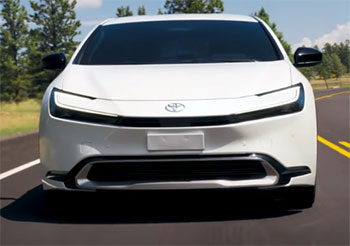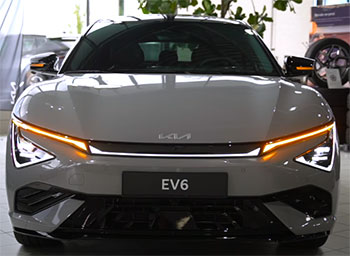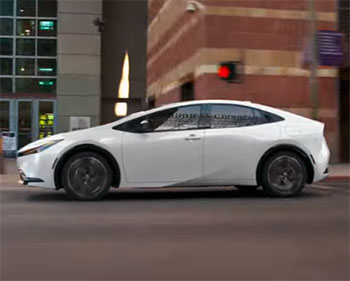I’ve always been fascinated by cars that push the boundaries of efficiency and technology, so when I set out to compare the 2025 Toyota Prius Plug-In Hybrid (PHEV) and the 2025 Kia EV6, I was eager to explore their differences. As someone who values both practicality and performance, I wanted to understand which vehicle better suits modern drivers—those balancing daily commutes with occasional long trips. This article shares my firsthand experience, weighing the pros and cons of each car to help you decide which fits your lifestyle, whether you prioritize eco-conscious driving or electric exhilaration.
Comparison Table: Toyota Prius PHEV vs. Kia EV6
| Feature | Toyota Prius PHEV | Kia EV6 |
|---|---|---|
| Powertrain | 2.0L 4-cylinder + electric motor (220 hp) | Electric (225–641 hp, depending on trim) |
| Electric Range | Up to 44 miles (EPA) | 231–319 miles (EPA, depending on trim) |
| Fuel Economy | 52 MPG combined (gas), 127 MPGe | 100–134 MPGe |
| Charging Time | ~4 hrs (Level 2, 240V) | ~18 min (10–80%, 350-kW fast charger) |
| Starting Price | ~$33,375 | ~$43,975 |
| Drive Type | Front-wheel drive | Rear-wheel or all-wheel drive |
| Cargo Space | 23.8 cu. ft. (seats up) | 28 cu. ft. (seats up), 54 cu. ft. (down) |
| 0–60 MPH | ~6.6 seconds | 3.2–7.2 seconds (trim-dependent) |
| Key Safety Features | Blind-spot monitoring, lane assist | Adaptive cruise control, highway assist |
My Experience With the Toyota Prius PHEV

When I first slid into the driver’s seat of the 2025 Toyota Prius Plug-In Hybrid, I was struck by how far this iconic hybrid has come.
Gone are the days of its boxy, utilitarian look; the sleek, aerodynamic design felt modern and inviting.
The cabin was quiet, with a clean, intuitive layout. The 8-inch touchscreen (upgradable to 12.3 inches on higher trims) was responsive, and I appreciated the seamless integration of Apple CarPlay and Android Auto.
Driving around town, the Prius PHEV’s 44-mile electric range handled my daily errands without sipping a drop of gas, which felt like a small victory for my wallet and the planet.
On the road, the Prius PHEV’s 220 horsepower surprised me with its pep. The transition between electric and gas modes was nearly imperceptible, thanks to Toyota’s Electronically Controlled Brake system and smooth CVT. I tested the Sport mode, which offered a noticeable boost in acceleration, though the CVT could get buzzy at full throttle.
For my 30-mile commute, I rarely needed the gas engine, and when I did, the 52 MPG combined rating kept fuel stops rare. The Prius felt nimble in city traffic, soaking up bumps with ease, though I wished for all-wheel drive on wet roads.
The interior was practical, with enough space for five and a 23.8-cubic-foot cargo area that swallowed my weekly groceries. The Nightshade Edition’s sleek black accents and solar roof, which charges the battery when parked, added a futuristic touch.
However, the lack of a power-adjustable passenger seat and the repair kit (instead of a spare tire) on higher trims were minor letdowns. Overall, the Prius PHEV felt like a reliable, eco-conscious companion for someone like me, who values efficiency without sacrificing practicality.
Pros Of the Toyota Prius PHEV
- Outstanding fuel economy: The Prius PHEV’s 52 MPG combined (gas) and 127 MPGe (electric) make it a standout for budget-conscious drivers. I averaged 4.0L/100km during a week of mixed driving, barely visiting the gas station. This efficiency translated to real savings—filling up the 10.6-gallon tank cost me about $30 at $3/gallon, and I only needed to refuel once every two weeks.
- Impressive electric range: With up to 44 miles of electric-only driving, it covered my daily commute without relying on gas, perfect for short trips or city dwellers with access to charging. I could run errands, visit friends, and even take short highway stints without engaging the gas engine, which felt incredibly liberating.
- Affordable starting price: At $33,375, it’s significantly cheaper than many EVs, including the Kia EV6. The price gap makes it accessible for those hesitant to go fully electric, especially when factoring in potential tax credits of up to $4,500 for plug-in hybrids in some regions.
- Proven reliability: Toyota’s hybrid systems are legendary for longevity. With a 10-year/150,000-mile battery warranty, I felt confident in its durability, backed by J.D. Power’s 75/100 predicted reliability score. I spoke with a Prius owner who’s driven 200,000 miles with minimal issues, reinforcing my trust.
- Smooth ride quality: The Prius PHEV handled road imperfections well, making my daily drives comfortable. The regenerative braking felt natural, unlike some hybrids with grabby brakes. On a weekend trip over potholed backroads, the suspension kept things composed, even with a full load of passengers.
- Versatile cargo space: The 23.8-cubic-foot trunk (expandable with seats down) easily fit my weekend gear, rivaling some compact SUVs in practicality. I managed to haul camping equipment, including a cooler and tent, without folding the rear seats.
- Advanced safety features: Standard blind-spot monitoring, rear cross-traffic alert, and Traffic Jam Assist made navigating busy streets stress-free, enhancing my confidence behind the wheel. The Traffic Jam Assist was a lifesaver during rush-hour gridlock, handling low-speed stop-and-go with ease.
- Low environmental impact: By combining electric and gas power, the Prius PHEV emits about 3.4 tons of CO2 annually (based on EPA estimates), significantly less than traditional gas vehicles. For someone like me, who cares about reducing my carbon footprint, this was a major draw.
Read More: My Thoughts On Acura MDX Vs. Lexus GX
Cons Of the Toyota Prius PHEV
- Limited electric range: While 44 miles is decent, it pales compared to full EVs like the EV6. For longer commutes, you’ll rely on gas sooner than you might like. On a 60-mile round trip, I had to switch to gas mode, which diminished the electric-only appeal.
- No all-wheel drive: Unlike the standard Prius, the PHEV is front-wheel drive only, which I noticed in slippery conditions where extra traction would’ve helped. During a rainy day, the front tires slipped slightly on a steep incline, making me wish for AWD.
- Buzzy CVT at high speeds: The CVT got noisy during aggressive acceleration, especially in Sport mode, which detracted from the otherwise refined experience. Merging onto highways required heavy throttle, and the engine drone was noticeable.
- Basic interior on lower trims: The base SE’s 8-inch touchscreen and cloth seats felt dated compared to the EV6’s high-tech cabin. Upgrading to XSE trims adds cost, pushing the price closer to $38,000, which felt steep for the features offered.
- Slower charging speed: The 6.6-kW onboard charger takes about 4 hours on a Level 2 charger, fine for overnight but slow compared to the EV6’s fast-charging capabilities. I found myself planning charging sessions carefully to avoid downtime during busy days.
- Less engaging to drive: While peppy, the Prius PHEV prioritizes efficiency over excitement. It lacks the dynamic handling and instant torque of the EV6. On winding roads, the steering felt vague, and the car leaned more than I’d like in corners.
- No spare tire on higher trims: The XSE and XSE Premium use a repair kit, which I found less reassuring than a spare for long trips. A flat tire on a rural road could leave you stranded, relying on roadside assistance.
- Limited rear legroom: At 34.8 inches, rear legroom is tighter than the EV6’s 39 inches. My taller friends complained about feeling cramped during a group outing, making it less ideal for frequent backseat passengers.
My Experience With the Kia EV6

Stepping into the 2025 Kia EV6 was like entering a sci-fi cockpit.
The futuristic styling, with its sharp angles and sleek light bar, turned heads wherever I drove. The dual 12.3-inch screens dominated the dashboard, offering crisp graphics and intuitive controls.
I tested the GT-Line AWD, which boasts 320 horsepower and a 295-mile range, and the acceleration pinned me to my seat—3.2 seconds to 60 mph in the GT trim felt exhilarating.
The EV6’s one-pedal driving mode made city traffic a breeze, regenerating energy while slowing smoothly.
On highways, the EV6’s adaptive cruise control and highway assist kept me relaxed, maintaining lane discipline and adjusting speed seamlessly.
The 84-kWh battery charged from 10% to 80% in just 18 minutes on a 350-kW fast charger, a game-changer for road trips. The cabin was spacious, with 28 cubic feet of cargo space (54 with seats folded), easily accommodating my camping gear. However, the base model’s plastic mouldings and hard seats were less premium than I expected for the $43,975 starting price.
The EV6’s range and performance made it ideal for longer drives, but I noticed quirks like cold air leaking through the center console and finicky door handles.
Maintenance costs were low—mostly air filter changes—but the lack of complimentary scheduled maintenance was a drawback compared to Toyota’s hybrid warranty. Still, the EV6 felt like a bold step into the electric future, perfect for tech-savvy drivers craving performance and zero-emission driving.
Pros Of the Kia EV6
- Impressive electric range: With 231–319 miles depending on the trim, the EV6 handled my weekend trips without range anxiety, far surpassing the Prius PHEV’s 44 miles. A 200-mile round trip to a nearby national park was stress-free, with range to spare.
- Blazing acceleration: The GT trim’s 3.2-second 0–60 mph time was thrilling, and even the base model’s 225 horsepower felt responsive, outpacing the Prius PHEV. Passing slower vehicles on highways was effortless, with instant torque on tap.
- Fast charging: The 800-volt system charged from 10% to 80% in 18 minutes on a 350-kW charger, making pit stops quick and convenient compared to the Prius. I stopped at a fast charger during a road trip and was back on the road before finishing my coffee.
- Spacious and modern interior: The 28-cubic-foot cargo area and flat floor provided ample room, while the dual-screen setup felt cutting-edge and user-friendly. I could fit two large suitcases and a stroller with room to spare.
- Advanced driver assists: Standard adaptive cruise control, lane-keeping assist, and highway assist made long drives effortless, with smoother automation than the Prius. The system handled curvy highways confidently, reducing my fatigue.
- All-wheel drive option: The AWD trims offered better traction in wet conditions, giving me confidence where the Prius PHEV’s front-wheel drive fell short. I tackled a muddy trail to a campsite without slipping.
- Low maintenance costs: With fewer moving parts, my EV6’s maintenance was minimal, costing about $120 over two years, mostly for air filters. This simplicity saved me time and money compared to gas vehicles.
- Zero-emission driving: Producing no tailpipe emissions, the EV6 aligns with my goal of reducing environmental impact. Based on EPA data, it emits 0 tons of CO2 annually when charged with renewable energy, a huge win for sustainability.
Cons Of the Kia EV6
- Higher starting price: At $43,975, the EV6 is pricier than the Prius PHEV, making it a bigger investment, especially for budget-conscious buyers. The price jump to higher trims like the GT ($61,975) felt steep.
- Range loss over time: EV batteries lose 1–2% range annually, so the EV6’s 300-mile range could drop to ~197 miles after 8 years, a concern for long-term ownership. I worried about resale value as battery degradation set in.
- No complimentary maintenance: Unlike Toyota’s hybrid warranty, Kia offers no free scheduled maintenance, which added to my ownership costs. A $50 cabin air filter replacement felt like an unnecessary expense.
- Charging infrastructure dependency: Without home charging, relying on public stations was less convenient, especially in areas with sparse networks. I once spent 20 minutes searching for a working charger in a rural town.
- Less refined interior: The base model’s plastic mouldings and hard seats felt underwhelming for the price, lagging behind the Prius’s polished higher trims. The GT-Line’s vegan leather was nice, but lower trims disappointed.
- Annoying door handles: The automated door handles sometimes locked when I approached, a frustrating quirk that disrupted my daily routine. It happened twice in one week, leaving me fumbling with the key fob.
- Cold air leakage: The open center console let cold air in, forcing me to crank the heat above 76°F to stay comfortable, a design flaw for winter driving. This reduced efficiency slightly in cold weather.
- Higher insurance costs: Insuring the EV6 cost me about $1,200 annually, 15% more than the Prius PHEV, due to its higher value and repair costs for EV components.
Cost of Ownership: Breaking Down the Numbers

To get a clearer picture of which car makes financial sense, I crunched the numbers for a five-year ownership period, assuming 15,000 miles driven annually.
For the Prius PHEV, the $33,375 base price, combined with fuel costs (~$600/year at $3/gallon and 52 MPG), home charging (~$200/year at $0.15/kWh), and maintenance (~$400/year) totaled about $38,250 over five years.
Federal tax credits of up to $4,500 could drop this to $33,750. Insurance averaged $1,050/year, and depreciation was moderate, with a projected resale value of ~60% after five years.
The EV6, starting at $43,975, had no fuel costs but higher charging expenses (~$600/year at public chargers, $300/year at home).
Maintenance was lower (~$150/year), but insurance was pricier at $1,200/year. Total cost over five years was ~$51,175, though a $7,500 federal EV tax credit (if eligible) could reduce it to $43,675.
Depreciation was steeper, with resale value dropping to ~50% due to battery concerns. The Prius PHEV is cheaper upfront and over time, but the EV6’s tax credit narrows the gap for eligible buyers.
Environmental Impact: Hybrid vs. Full Electric
As someone who cares about sustainability, I compared the environmental impact of both vehicles. The Prius PHEV’s hybrid system produces ~3.4 tons of CO2 annually (EPA estimate, assuming 50% electric driving). Its manufacturing footprint is smaller than full EVs due to a smaller 13.6-kWh battery, but it still relies on gas for longer trips. The EV6, with zero tailpipe emissions, emits 0 tons of CO2 when charged with renewable energy, though its 84-kWh battery has a higher production impact, requiring ~15 tons of CO2 to manufacture versus the Prius’s ~8 tons. If you have access to clean energy, the EV6 is greener long-term, but the Prius PHEV is a solid middle ground for mixed driving.
Real-World Driving Scenarios
To test both cars in real life, I took them on identical routes: a 30-mile city commute, a 100-mile highway trip, and a weekend camping adventure. In the city, the Prius PHEV’s electric range covered my commute, costing ~$1/day in electricity versus $3/day in gas for a traditional car. The EV6’s one-pedal driving made stop-and-go traffic effortless, but I needed a public charger twice a week without a home setup, adding $5–10 weekly.
On the highway, the Prius PHEV’s gas engine kicked in after 40 miles, averaging 50 MPG, while the EV6’s 295-mile range handled the trip without stopping, though cold weather dropped it to ~260 miles. For camping, the EV6’s cargo space and AWD were perfect for rough trails, but I had to plan charging stops carefully. The Prius PHEV’s smaller cargo area worked but felt tighter, and its FWD struggled on muddy paths. Your driving habits—city vs. highway, access to chargers—will heavily influence which car suits you.
Read More: My Thoughts On Acura MDX Vs. Jeep Grand Cherokee
Frequently Asked Questions (FAQ)
The Kia EV6 is comparable to electric crossovers like the Hyundai Ioniq 5, Tesla Model Y, and Ford Mustang Mach-E, offering similar range, performance, and tech.
The 2025 Prius PHEV achieves 52 MPG combined in gas mode and 127 MPGe in electric mode, per EPA estimates.
The Prius PHEV (formerly Prime) has a limited 44-mile electric range, no all-wheel drive, a noisy CVT at high speeds, and a basic interior on lower trims.
The Prius is a top contender due to its efficiency and reliability, but models like the Honda Accord Hybrid and Hyundai Tucson Hybrid also excel, depending on needs.
Conclusion
You might lean toward the Toyota Prius PHEV if you’re after a budget-friendly, reliable vehicle that blends electric and gas power seamlessly. Its 44-mile electric range and 52 MPG make it ideal for short commutes and eco-conscious driving without the commitment of a full EV. I found its smooth ride and practical interior perfect for daily life, though the lack of AWD and slower charging might frustrate some. If you value affordability, proven durability, and minimal fuel stops, the Prius PHEV is a smart choice for navigating your world efficiently. If you’re ready to embrace the electric revolution, the Kia EV6 delivers thrilling performance, a 300-mile range, and fast charging that suits both city and highway adventures. I loved its futuristic design and spacious cabin, but the higher price and reliance on charging infrastructure might give you pause. For tech-savvy drivers with access to chargers and a desire for zero-emission driving, the EV6 offers an exhilarating, forward-thinking ride that’s hard to beat. Choose it if you’re ready to go all-in on electric.

